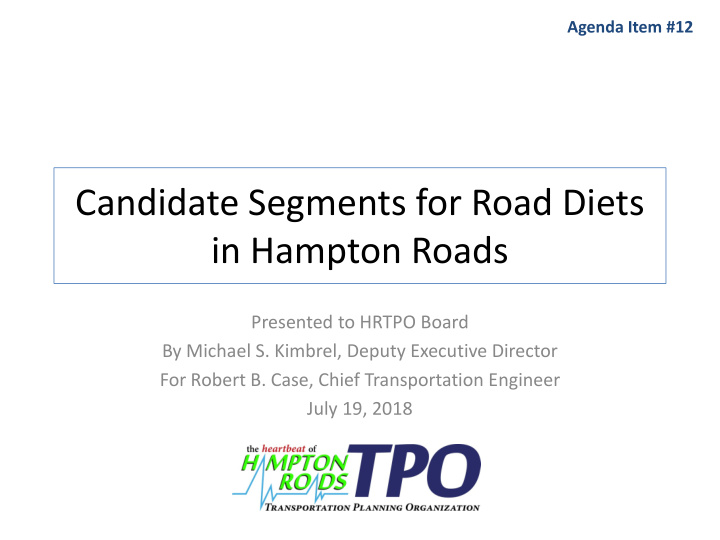



Agenda Item #12 Candidate Segments for Road Diets in Hampton Roads Presented to HRTPO Board By Michael S. Kimbrel, Deputy Executive Director For Robert B. Case, Chief Transportation Engineer July 19, 2018
Road Diet - Definition “ Roads are for getting to a place. Streets are for being in a place.” * * Charles Marohn, author of Thoughts on Building Strong Towns Road diets convert a road into a street Ocean View Ave., Norfolk 2 Source: City of Norfolk (IMG_0618- trimmed.jpg)
Road Diet - Definition • Reducing the number of thru lanes • Reusing the available road width for: – Two-way left-turn lane (TWLTL) – Parking – Bike lanes – Etc. 3
Study Purpose To identify candidate roadway segments and related information localities may consider for possible road diet implementation Road Diet on South Plaza Trail, Va. Beach 4 Source: google maps
Project Steering Team • Chesapeake – Ben Camras • Newport News – Garrett Morgan • Norfolk – Jeff Raliski, John Stevenson • Portsmouth – Susan Wilson • VDOT – Eric Stringfield, Jerry Pauley • Virginia Beach – Bob Gey, Brian Solis, Wayne Wilcox, Ric Lowman 5
Study Methodology • Conducted a literature review on how road diets work . • Applied that knowledge in the analysis roadways in Hampton Roads. 6
Literature Review 1. Public response to road diets 2. Cost, construction, and post-construction 3. Transportation impacts 7
Public Response to Road Diets Typically, road diets have been well- received by the public. 8
Cost, Construction, and Post-Construction • Construction Cost: – typically low • Construction: – typically quick to implement • Post-Construction: – can modify , even remove 9
Transportation Impacts • Improved Safety • Lower Vehicle Speeds • Reduced Intersection Delay • Reduced Crash Rates Before • Increased Bicycle Use • Increased Walking • Increased Bus Ridership 10 After
Road Diet Candidates A Road Diet may be desirable for: – Segments with lower traffic volumes (less than 15,000 vehicles/day) – Segments with higher crash rates – Segments for which localities wish to accommodate cycling, bus transit, and walking – Segments for which localities wish to improve access to street-oriented land uses • e.g. residential, shops, restaurants, parks, museums, etc. 11
Application to Hampton Roads HRTPO staff analyzed every 4-lane undivided roadway with low traffic volumes, noting : – Crashes - location and rate – Bike/ped facilities in vicinity – People in area who bike, walk, or use transit to get to work – Existing bus routes – Existing or potential street-oriented land use 12
Maps Showing Bike/Ped/Transit 13
Observations 14
50+ Miles of Candidate Roadways 15
Next Steps • Localities may use Study maps, data, and observations to help select candidate roadway segments to further investigate for possible Road Diet implementations . • HRTPO staff recommends that localities conduct a Road Diet Feasibility Determination (see FHWA Road Diet Information Guide ) as part of such investigations. 16
Recommended Action • Approve the final report for distribution under Agenda Item #19-I. 17
Recommend
More recommend